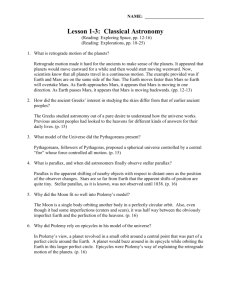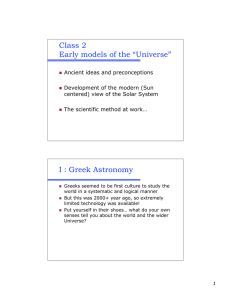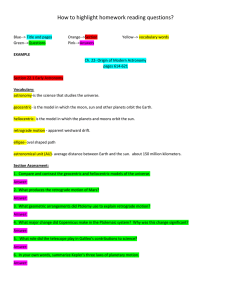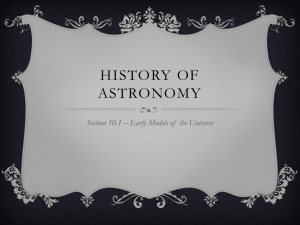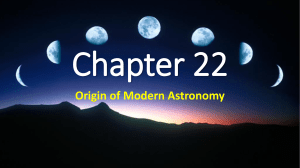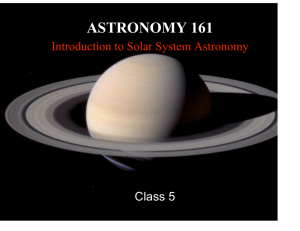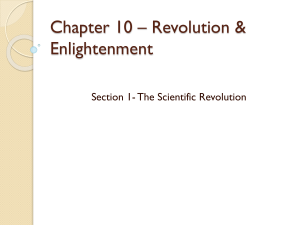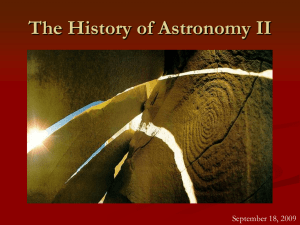Giants of Science - Academic Computer Center
advertisement
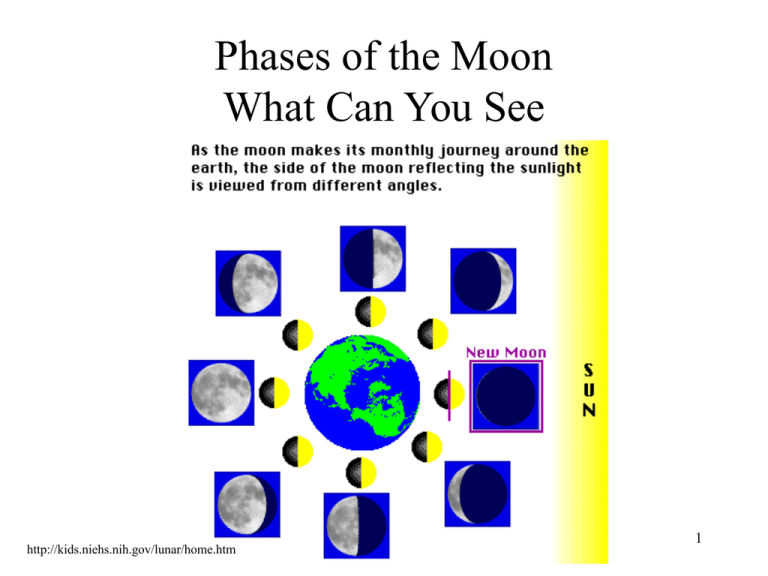
Phases of the Moon What Can You See http://kids.niehs.nih.gov/lunar/home.htm 1 Phases of the Moon When Can You See It 2 Giants of Science • Our understanding of the Universe developed slowly over centuries. • Most of the breakthroughs came through careful study of the positions and motions of the Sun, Moon, planets and stars. • The careful analysis of these large sets of measurements and the use of mathematics led to the creation of physical models that were used to make predictions on the future position of planets, Sun, Moon, etc. • When these models failed to explain observed phenomena they were abandoned or modified. (eventually!) • The following is a short summary of several notable philosopher/scientists and their contributions. 3 Aristotle (c. 384 - 322 B.C.) • Taught that the Earth was the unmoving center of the Universe. • Taught that the Earth was spherical – Lunar eclipses due to Earth’s shadow are always round. – Different stars are visible the farther South you go. Two examples Aristotle used to prove the Earth is a sphere. 4 Aristarchus (c. 310 - 230 B.C.) • Used geometry to measure the size and distance of the Moon & Sun. Moon results were good. Sun results were bad. • Showed that the Sun was bigger than Earth and much farther than the Moon. • Taught that the Earth went around the Sun. (Not much proof 5 and not widely accepted). Aristarchus (c. 310 - 230 B.C.) Relative Distances 6 Stellar Parallax Stellar Parallax application • Parallax - the shift in an object’s position caused by the observer’s motion. • Since the Earth moves we should see parallax but we don’t. • No one realized that stars are very far away so parallax is a very small effect. • Only with powerful telescopes can they be observed. 300 years later the first parallax was observed. 7 Eratosthenes (c. 276 - 196 B.C.) • Used shadows and geometry to measure the size of the Earth! • On Summer Solstice Sun was directly overhead in Syene, Egypt.(no shadows at noon) • On the same day there were shadows at noon in Alexandria, Egypt. • Using shadow length and distance between Syene and Alexandria and geometry found Earth’s circumference. • His value probably around 42,000 kilometers. • Actual value about 40,000 km. 8 Ptolemy (100 - 170 A.D.) • Last of the great Greek astronomers • Used discoveries and ideas of others plus his own observations to develop a model of the Universe. • His work survived from Arabic translation of Almagest (means the greatest compilation) • His model of the Universe was undisputed for almost 1,400 years! 9 Ptolemy’s Model of the Universe • A geocentric (Earthcentric) model • All the stars, planets, Sun and Moon moved around the Earth • Motions were perfectly circular and perfectly uniform • Fastest objects were closest to Earth. 10 Retrograde Motion • It was well known that the planets occasionally appear to stop and change direction in orbit, but why? • It is an illusion based on the motion of the Earth and the planet. • Ptolemy explained this effect without moving Earth. He used epicycles instead. Retrograde Motion Application 11 Epicycles The large circle is called a deferent the smaller circle is an epicycle. • In a Ptolemy’s model these are small circles to which the planets are fixed. • These epicycles are attached to the larger circles which move around Earth. • Ptolemy adjusted the sizes of the circles and their rate of motion to replicate the motion of the planets including retrograde motion. • Planets maintained perfect uniform, circular motion. 12 Nicholas Copernicus (1473 - 1543) • Recognized that the predicted planetary positions using Ptolemy’s model were not always very accurate. • Tried to fix Ptolemy’s model but eventually abandoned it. • Returned to the idea of Aristarchus 1800 years before. • Created a heliocentric (Suncentric) model of the Universe. Finding the distance of the planets from the Sun using Copernicus’ heliocentric model. – Made retrograde motion easier to explain. – Distances of the planets from the Sun could be determined using geometry 13 Problems with Copernicus’ Model • Copernicus maintained that all planets move in perfectly circular orbits at constant rates (not correct). • Didn’t really do much better than Ptolemy at predicting planetary positions. He actually needed to keep epicycles to make the model work out right. • Several objections – We don’t feel the Earth moving. Went against “commonsense”. Went against philosophical (Aristotle) and religious beliefs. – Why don’t we see stellar parallax? – For these reasons it was not widely accepted at first 14
